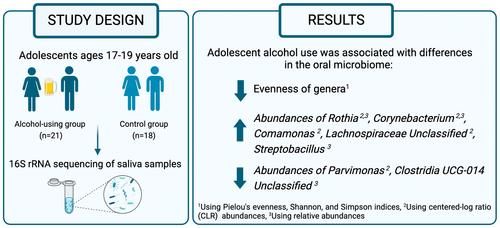Adolescent alcohol use is associated with differences in the diversity and composition of the oral microbiome
Abstract
Background
Adolescence is a sensitive stage of oral microbial development that often coincides with the initiation and escalation of alcohol use. Thus, adolescents may be particularly susceptible to alcohol-induced alterations in the oral microbiome, though minimal research has been done in this area. Understanding the connection between the oral microbiome and alcohol use during adolescence is important to understand fully the biological consequences of alcohol use to mitigate potential adverse outcomes.
Methods
Saliva samples were collected from adolescents aged 17–19 who used alcohol heavily (n = 21, 52.4% female) and those who did not use alcohol or any other substances (n = 18, 44.4% female). We utilized 16S rRNA sequencing to examine differences in microbial diversity and composition between the groups.
Results
For alpha diversity, evenness was significantly lower in the drinking group than the control group as indicated by Pielou's evenness, Shannon, and Simpson indices. There were no statistically significant findings for beta diversity. Differential abundance analyses revealed higher abundances of Rothia and Corynebacterium in the alcohol-using group using both centered-log-ratio and relative abundance normalization. These genera are known for their high capacity to convert alcohol into acetaldehyde, a toxic metabolite reported to play a role in the neurobiological effects of alcohol. An unclassified Clostridia UCG-014, Streptobacillus, Comamonas, unclassified Lachnospiraceae, and Parvimonas were also identified as significantly different between groups when using only one of the normalization techniques.
Conclusions
This is the first study designed specifically to compare the oral microbiome of adolescents who use alcohol with that of control participants. Our findings reveal distinct alcohol-related differences in microbial composition and taxon abundance, emphasizing the importance of understanding the impact on the oral microbiome of alcohol use during adolescence. Because the oral microbiome is malleable, this study provides foundational work for future prevention and intervention studies.


 求助内容:
求助内容: 应助结果提醒方式:
应助结果提醒方式:


